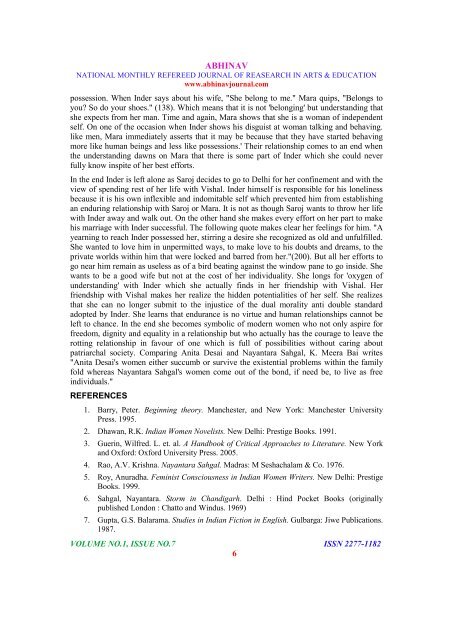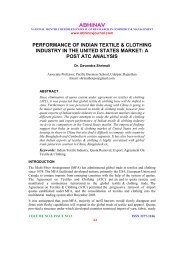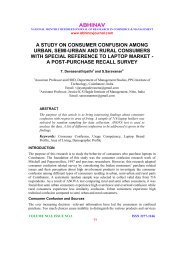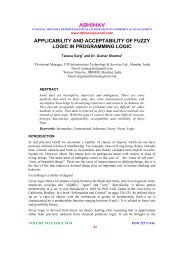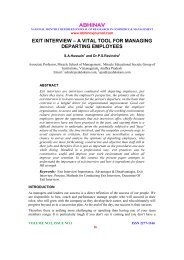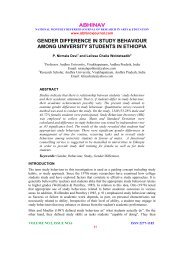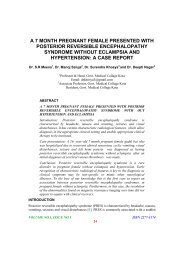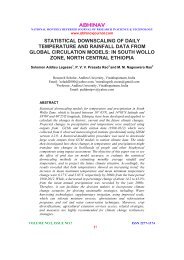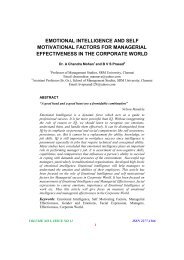Nayantara Sehgal: Feministic Currents in Storm in Chandigarh
Nayantara Sehgal: Feministic Currents in Storm in Chandigarh
Nayantara Sehgal: Feministic Currents in Storm in Chandigarh
Create successful ePaper yourself
Turn your PDF publications into a flip-book with our unique Google optimized e-Paper software.
ABHINAV<br />
NATIONAL MONTHLY REFEREED JOURNAL OF REASEARCH IN ARTS & EDUCATION<br />
www.abh<strong>in</strong>avjournal.com<br />
possession. When Inder says about his wife, "She belong to me." Mara quips, "Belongs to<br />
you So do your shoes." (138). Which means that it is not 'belong<strong>in</strong>g' but understand<strong>in</strong>g that<br />
she expects from her man. Time and aga<strong>in</strong>, Mara shows that she is a woman of <strong>in</strong>dependent<br />
self. On one of the occasion when Inder shows his disguist at woman talk<strong>in</strong>g and behav<strong>in</strong>g.<br />
like men, Mara immediately asserts that it may be because that they have started behav<strong>in</strong>g<br />
more like human be<strong>in</strong>gs and less like possessions.' Their relationship comes to an end when<br />
the understand<strong>in</strong>g dawns on Mara that there is some part of Inder which she could never<br />
fully know <strong>in</strong>spite of her best efforts.<br />
In the end Inder is left alone as Saroj decides to go to Delhi for her conf<strong>in</strong>ement and with the<br />
view of spend<strong>in</strong>g rest of her life with Vishal. Inder himself is responsible for his lonel<strong>in</strong>ess<br />
because it is his own <strong>in</strong>flexible and <strong>in</strong>domitable self which prevented him from establish<strong>in</strong>g<br />
an endur<strong>in</strong>g relationship with Saroj or Mara. It is not as though Saroj wants to throw her life<br />
with Inder away and walk out. On the other hand she makes every effort on her part to make<br />
his marriage with Inder successful. The follow<strong>in</strong>g quote makes clear her feel<strong>in</strong>gs for him. "A<br />
yearn<strong>in</strong>g to reach Inder possessed her, stirr<strong>in</strong>g a desire she recognized as old and unfulfilled.<br />
She wanted to love him <strong>in</strong> unpermitted ways, to make love to his doubts and dreams, to the<br />
private worlds with<strong>in</strong> him that were locked and barred from her."(200). But all her efforts to<br />
go near him rema<strong>in</strong> as useless as of a bird beat<strong>in</strong>g aga<strong>in</strong>st the w<strong>in</strong>dow pane to go <strong>in</strong>side. She<br />
wants to be a good wife but not at the cost of her <strong>in</strong>dividuality. She longs for 'oxygen of<br />
understand<strong>in</strong>g' with Inder which she actually f<strong>in</strong>ds <strong>in</strong> her friendship with Vishal. Her<br />
friendship with Vishal makes her realize the hidden potentialities of her self. She realizes<br />
that she can no longer submit to the <strong>in</strong>justice of the dual morality anti double standard<br />
adopted by Inder. She learns that endurance is no virtue and human relationships cannot be<br />
left to chance. In the end she becomes symbolic of modern women who not only aspire for<br />
freedom, dignity and equality <strong>in</strong> a relationship but who actually has the courage to leave the<br />
rott<strong>in</strong>g relationship <strong>in</strong> favour of one which is full of possibilities without car<strong>in</strong>g about<br />
patriarchal society. Compar<strong>in</strong>g Anita Desai and <strong>Nayantara</strong> Sahgal, K. Meera Bai writes<br />
"Anita Desai's women either succumb or survive the existential problems with<strong>in</strong> the family<br />
fold whereas <strong>Nayantara</strong> Sahgal's women come out of the bond, if need be, to live as free<br />
<strong>in</strong>dividuals."<br />
REFERENCES<br />
1. Barry, Peter. Beg<strong>in</strong>n<strong>in</strong>g theory. Manchester, and New York: Manchester University<br />
Press. 1995.<br />
2. Dhawan, R.K. Indian Women Novelists. New Delhi: Prestige Books. 1991.<br />
3. Guer<strong>in</strong>, Wilfred. L. et. al. A Handbook of Critical Approaches to Literature. New York<br />
and Oxford: Oxford University Press. 2005.<br />
4. Rao, A.V. Krishna. <strong>Nayantara</strong> Sahgal. Madras: M Seshachalam & Co. 1976.<br />
5. Roy, Anuradha. Fem<strong>in</strong>ist Consciousness <strong>in</strong> Indian Women Writers. New Delhi: Prestige<br />
Books. 1999.<br />
6. Sahgal, <strong>Nayantara</strong>. <strong>Storm</strong> <strong>in</strong> <strong>Chandigarh</strong>. Delhi : H<strong>in</strong>d Pocket Books (orig<strong>in</strong>ally<br />
published London : Chatto and W<strong>in</strong>dus. 1969)<br />
7. Gupta, G.S. Balarama. Studies <strong>in</strong> Indian Fiction <strong>in</strong> English. Gulbarga: Jiwe Publications.<br />
1987.<br />
VOLUME NO.1, ISSUE NO.7 ISSN 2277-1182<br />
6


